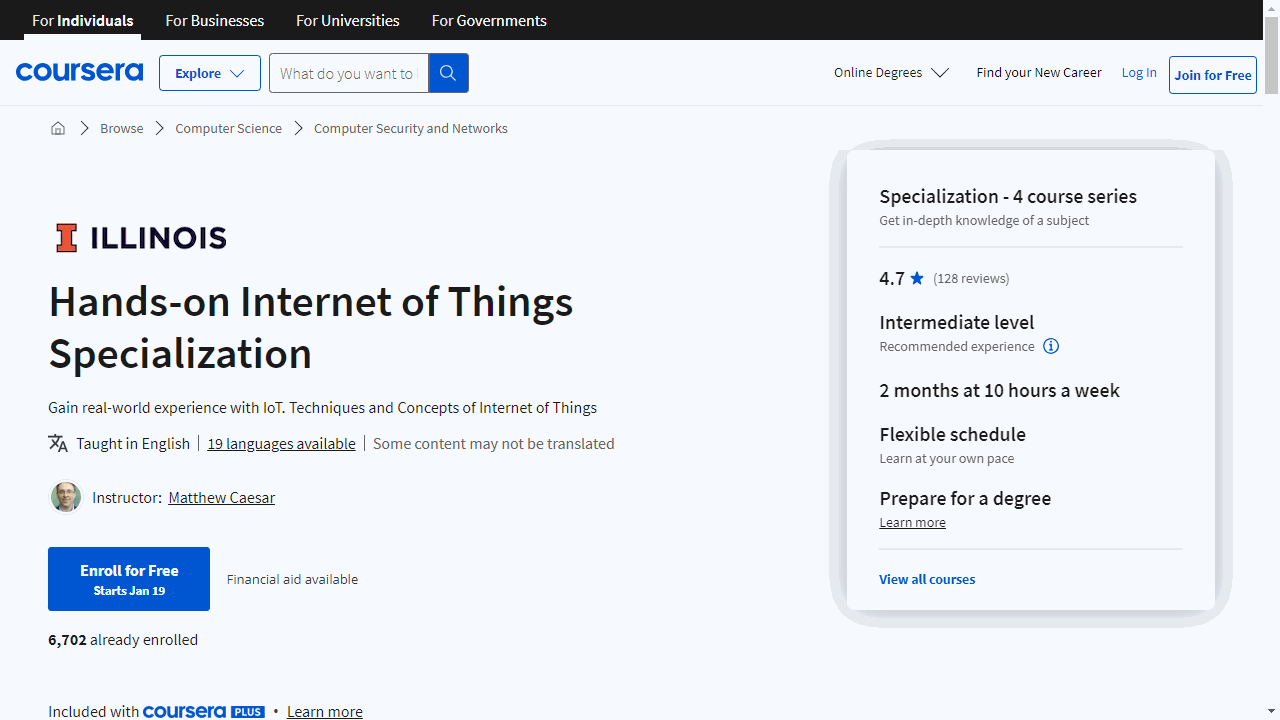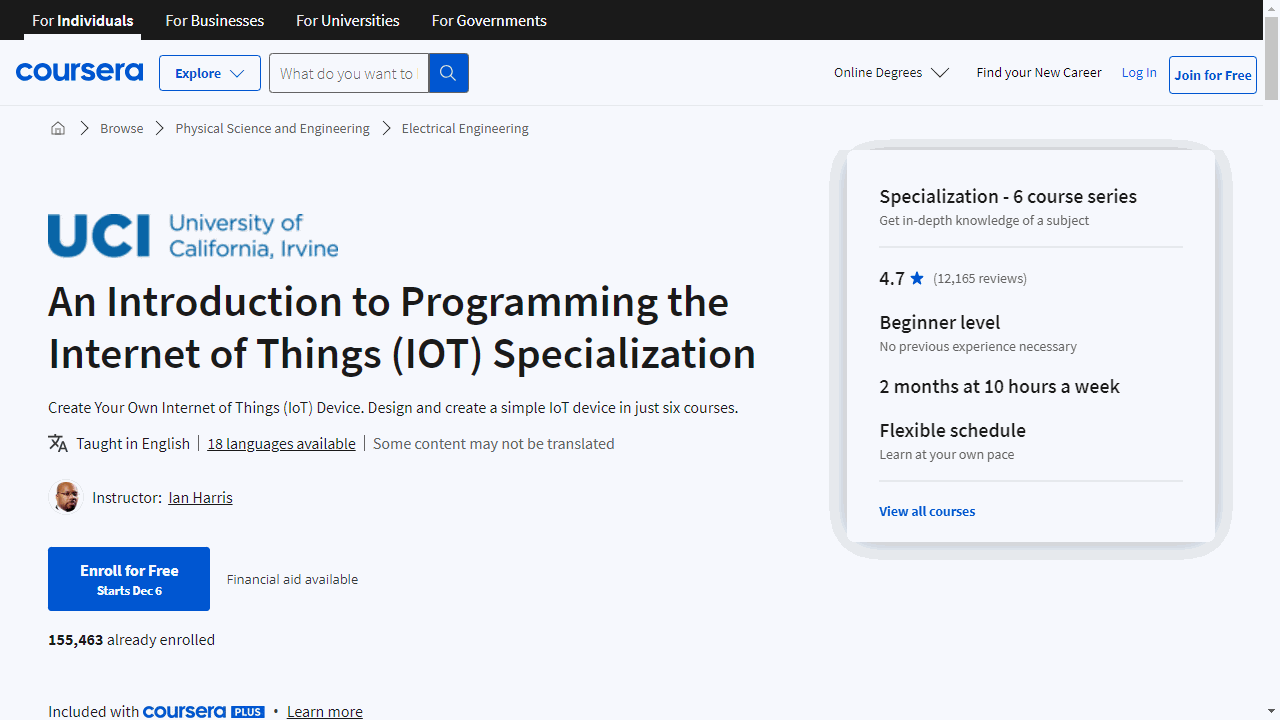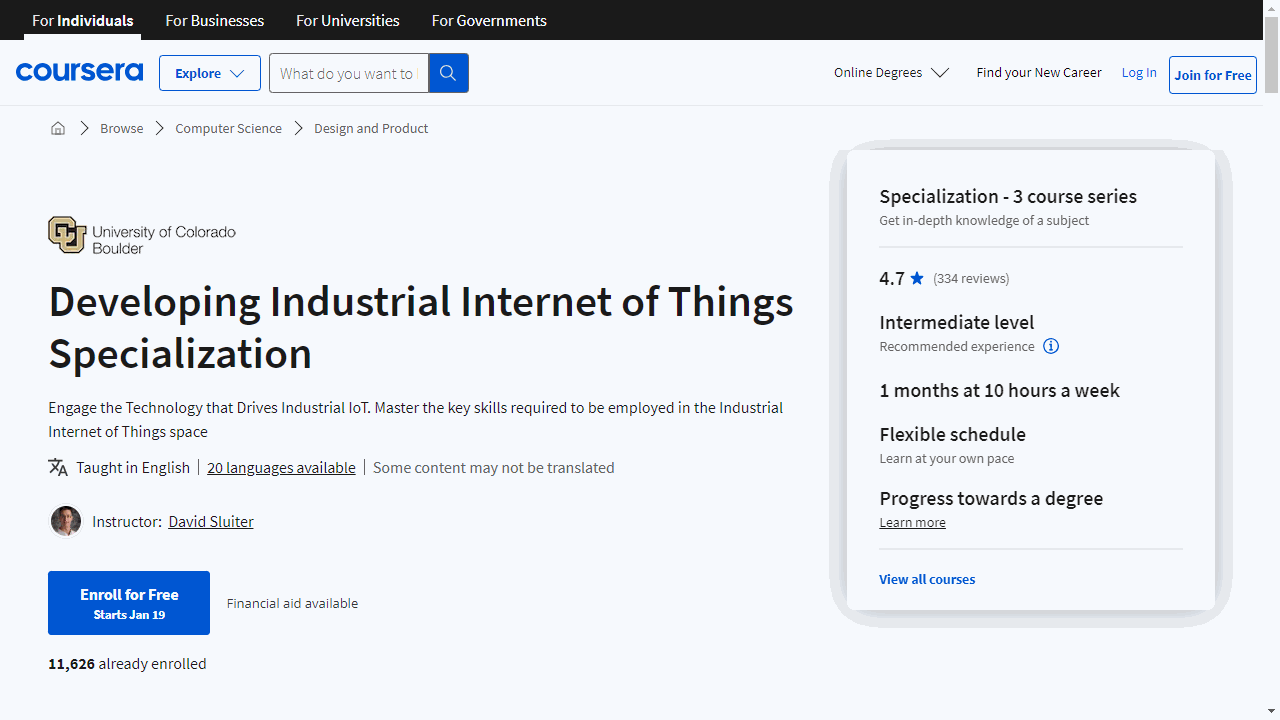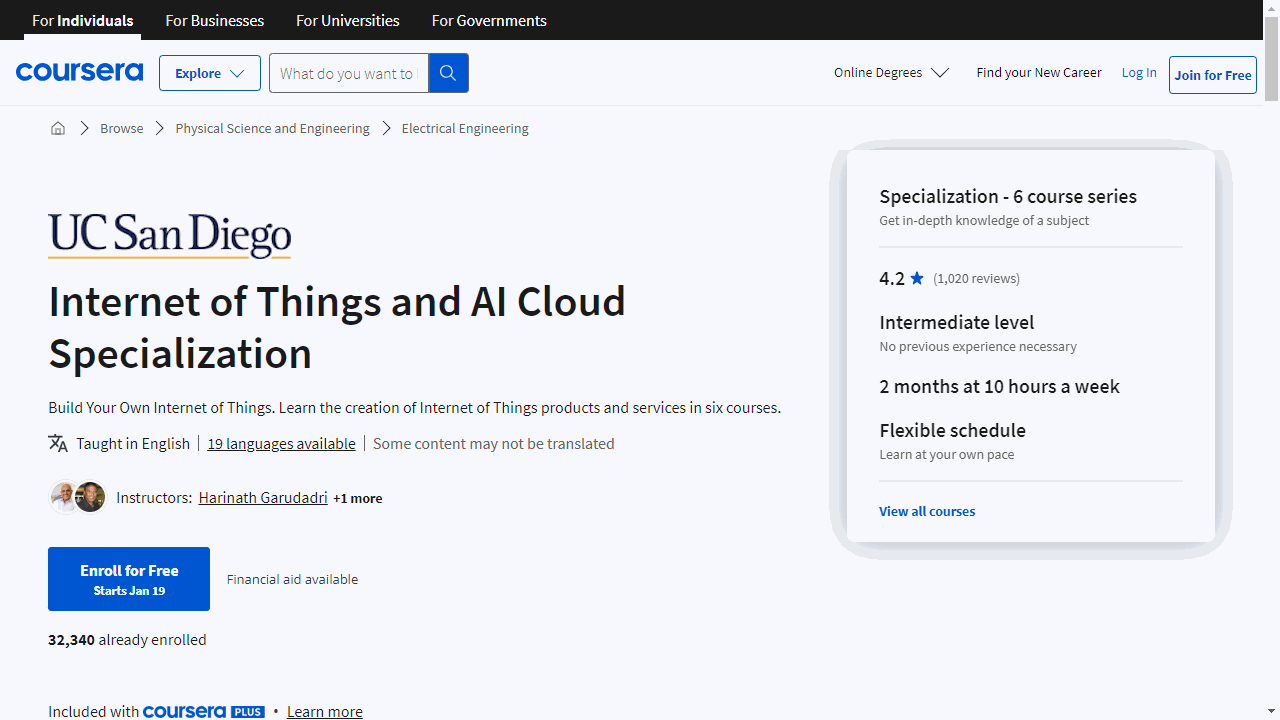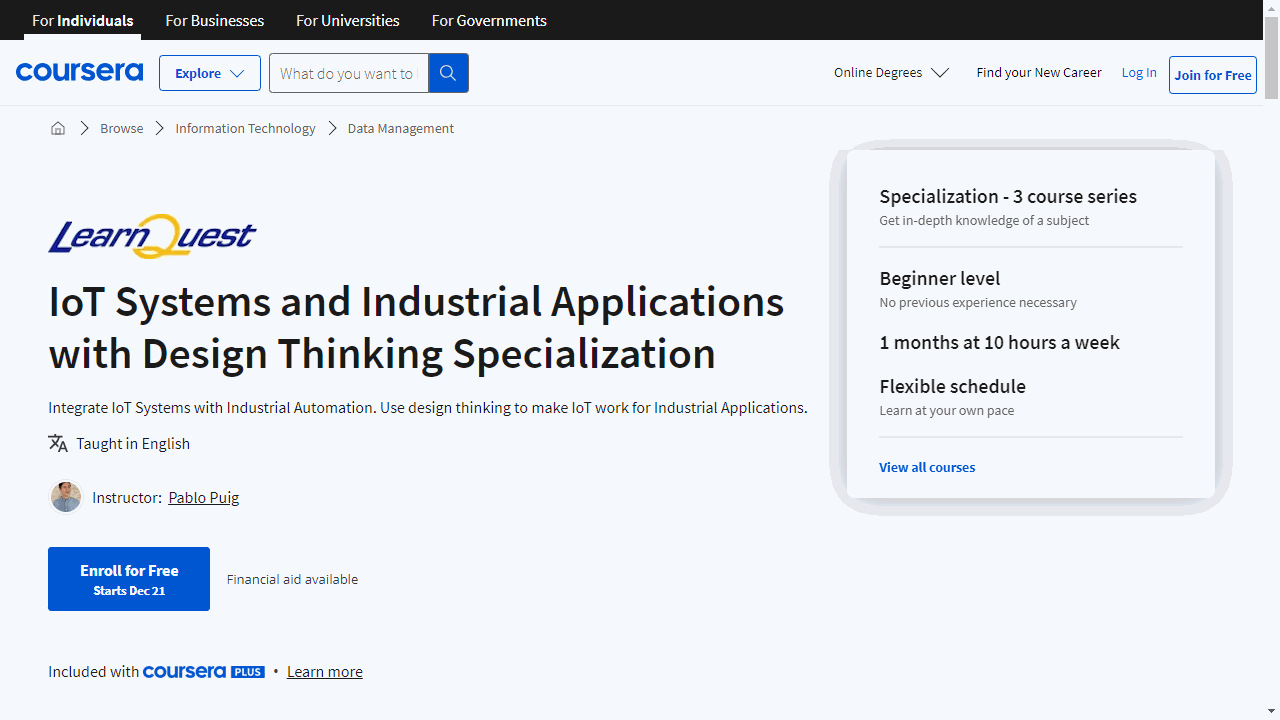The Internet of Things (IoT) is transforming our world, connecting devices and enabling seamless communication and data exchange.
This technology is revolutionizing industries, from healthcare and manufacturing to smart homes and transportation.
By mastering IoT, you can gain valuable skills to build and manage connected systems, contributing to innovative solutions that enhance efficiency and create new possibilities.
Finding the right IoT course on Coursera can be a challenge, with many programs vying for your attention.
You’re searching for a course that’s comprehensive, engaging, and taught by experts, but also aligns with your learning style and career goals.
We recommend the Hands-on Internet of Things Specialization offered by the University of Illinois at Urbana-Champaign as the best IoT course overall.
This specialization blends theoretical knowledge with practical experience, covering essential concepts like device programming, networking, security, and cloud integration.
The hands-on approach, using Arduino and Raspberry Pi, allows you to apply your learning directly and build your own IoT projects.
This is just one of many excellent IoT courses on Coursera.
Explore our recommendations for different learning levels and specific areas of IoT, including cloud computing, industrial applications, and security.
Find the perfect course for your journey and unlock the power of the interconnected world.
Hands-on Internet of Things Specialization
Provider: University of Illinois at Urbana-Champaign
This specialization is a blend of in-depth knowledge and practical experience, designed to equip you with the skills needed to excel in the IoT field.
Kick off with “IoT Devices” and master IoT device programming with Arduino and Raspberry Pi.
You’ll explore sensing, actuating, and dive into IoT protocols like Zigbee and MQTT.
This course emphasizes security and networking, preparing you to deploy IoT solutions like a wifi monitoring service.
Keep in mind, you’ll need to invest in some hardware to get the full hands-on experience.
In “IoT Communications,” you’ll enhance your device’s connectivity.
Tackle radio frequency communication, the MAC layer, and Mesh Networking, and apply these concepts to improve your device’s communication capabilities.
Move on to “IoT Networking” to understand enterprise IoT.
You’ll face the challenges of network connectivity and learn about the backbone of IoT infrastructure, ensuring your devices can securely access the Internet and services they need.
Conclude with “IoT Cloud,” where you’ll delve into cloud technologies and machine learning.
Understand the roles of network devices like routers and switches, and configure them to support a resilient IoT network.
By the end of this specialization, you’ll have a robust skill set in internet technologies, wireless communication, and both front and back-end development.
You’ll be ready to create and manage intelligent IoT systems.
An Introduction to Programming the Internet of Things (IOT) Specialization
This specialization offered by University of California, Irvine equips you with the essentials of IoT and embedded systems, focusing on practical applications and hands-on learning.
The journey begins with “Introduction to the Internet of Things and Embedded Systems,” where you’ll grasp the significance of IoT and its societal impact.
You’ll learn about the components that make up IoT devices, including interfacing with the physical world and networking basics.
Skills in Arduino and Python programming are key takeaways.
Moving on to “The Arduino Platform and C Programming,” you’ll get familiar with the Arduino board, understanding its hardware and software aspects.
You’ll also learn to program in C, manage input and output pins, and use shields for expanded functionality.
In “Interfacing with the Arduino,” the focus shifts to connecting sensors and interpreting signals.
This course is crucial for learning how to make your devices interact with their environment.
“The Raspberry Pi Platform and Python Programming for the Raspberry Pi” introduces you to this compact computer.
You’ll set up the Raspberry Pi, run Linux, and execute Python code, gaining valuable programming and hardware knowledge.
“Interfacing with the Raspberry Pi” builds on this by teaching you to communicate with external devices using various protocols.
This course is essential for creating sophisticated IoT devices that can sense and act upon data.
The capstone, “Programming for the Internet of Things Project,” challenges you to design and potentially build a microcontroller-based system, integrating all the skills you’ve acquired.
Developing Industrial Internet of Things Specialization
Provider: University of Colorado Boulder
This specialization targets the expansive and evolving field of the Industrial Internet of Things (IIoT), giving you a solid foundation in Industry 4.0.
Kick off with “Industrial IoT Markets and Security,” where you’ll grasp the essence of Industry 4.0 and the skills needed to thrive in the IIoT domain.
You’ll explore critical platforms, dive into market insights, and understand the significance of security, including encryption and data protection methods.
Move on to “Project Planning and Machine Learning,” where you’ll master project execution, learn to create detailed bills of materials, and delve into sensor technology.
The course also introduces you to the basics of machine learning and the importance of big data, setting you up for success in data-driven decision-making.
The third course, “Modeling and Debugging Embedded Systems,” hones your technical expertise.
You’ll work with SystemC for cyber-physical system modeling and gain a deeper understanding of embedded systems within the automotive sector.
Debugging skills are sharpened with tools like Lauterbach’s TRACE32, and you’ll learn the art of promoting technical ideas and analyzing engineering failures.
By completing this specialization, you’ll develop in-demand skills in automation, debugging, and embedded systems.
Whether you’re aiming for academic credit or building a career in IIoT, these courses offer practical knowledge and insights from industry experts.
Internet of Things and AI Cloud Specialization
Provider: University of California San Diego
This comprehensive program takes you from the roots of IoT to crafting your own innovative projects.
Dive into “Internet of Things: How did we get here?”
to uncover the fascinating evolution of smartphones, GPS, and the internet.
You’ll explore the convergence of telephony, broadcast networks, and multimedia, gaining insights into how these technologies shape our daily lives.
By the end, you’ll grasp how communication has transformed over time and the workings of platforms like email and YouTube.
Move on to “Internet of Things V2: DragonBoard™ bring up and community ecosystem” for a hands-on experience with the DragonBoard™ 410c.
This course equips you with Linux skills, introduces you to the 96Boards ecosystem, and sharpens your version control abilities with Git and GitHub.
It’s ideal if you’re pivoting your career toward IoT or if you’re an innovator ready to bring your ideas to life.
With “Internet of Things V2: Setting up and Using Cloud Services,” you’ll become proficient with AWS, learning to integrate cloud services into your IoT projects.
You’ll navigate tools like EC2 and IoT, essential for anyone looking to harness the power of the cloud.
In “Internet of Things: Communication Technologies,” you’ll unravel how IoT devices communicate.
You’ll get to build your own app for voice and text using the Session Initiation Protocol (SIP) and understand the nuances of voice codecs, setting the stage for robust IoT communication solutions.
For multimedia enthusiasts, “Internet of Things: Multimedia Technologies” offers a deep dive into video and audio codecs.
You’ll learn to balance media quality with bandwidth and develop a media player application, a skill set in high demand in the digital content space.
Cap it all off with the “Internet of Things Capstone V2: Build a Mobile Surveillance System,” where you’ll apply your knowledge to design and build a system with sensors, actuators, and communication protocols.
Whether you opt for the suggested surveillance system or your own concept, you’ll emerge with a showcase-worthy project.
This specialization is a blend of theory and practical application, preparing you for the real-world IoT landscape.
You’ll gain a robust foundation in IoT essentials, from the evolution of communication technologies to the integration of cloud services and multimedia.
IoT Systems and Industrial Applications with Design Thinking Specialization
Provider: LearnQuest
This specialization equips you with a robust understanding of IoT’s role in revolutionizing industrial automation and robotics.
Kick off with “Foundations of IoT Systems and Industrial Automation” to build your base.
You’ll explore the evolution and architecture of IoT, delve into sensor technologies, and examine communication protocols.
This course goes beyond theory, showcasing IoT’s practical impact on industries like manufacturing.
You’ll emerge with the know-how to manage data, enhance security, and uphold privacy in IoT systems.
Move on to “Design Thinking for Human-Centered IoT Solutions” to master a user-first approach.
Here, you’ll apply design thinking to craft IoT solutions that truly resonate with users.
Learn to empathize with user needs, ideate solutions, prototype, and test.
This course is ideal if you’re an engineer, developer, or manager looking to create meaningful IoT applications.
Conclude with “Advanced IoT Systems Integration and Industrial Applications” for a deep dive into sophisticated IoT topics.
This course covers edge computing, advanced data analytics, and the fusion of IoT with robotics.
You’ll gain practical skills to address real-world industrial challenges, ensuring IoT systems are secure and effectively integrated with robotics for enhanced automation.
By completing this specialization, you’ll have a comprehensive skill set in systems design, data management, and user-centric design.
Assessing and Managing Secure IoT Applications and Devices Specialization
Provider: LearnQuest
If you’re eager to master IoT security and manage risks effectively, this specialization is the perfect match for you.
It’s a comprehensive learning journey that prepares you to protect IoT applications and devices against emerging threats.
Kick off with “Foundations of Secure IoT Architecture,” where you’ll dissect the IoT ecosystem, pinpoint security challenges, and tackle threats.
You’ll learn to assess risks, adopt best practices, and understand security standards.
Plus, you’ll delve into secure communication protocols, setting you up to make informed security decisions.
Move on to “Managing IoT Security in Networks,” where you’ll get a closer look at IoT architecture and connectivity.
This course sharpens your ability to identify IoT threats and vulnerabilities.
You’ll master risk assessment techniques and threat modeling, ensuring you can navigate the complex IoT security landscape with confidence.
Finally, “Securing the IoT Landscape: From Inception to Architecture” offers a deep understanding of IoT security.
You’ll cover the Device Identity lifecycle, learn to set up a Security Incident Response Team, and dive into threat modeling with the ATASM framework.
The course also provides practical insights on tools like Microsoft Defender and strategies for Cloud IAM, preparing you to secure IoT ecosystems from device to cloud.
Throughout these courses, you’ll gain hands-on skills in penetration testing, vulnerability management, and incident response.
You’ll also become proficient in secure communication, risk assessment, and ecosystem management, all crucial for safeguarding IoT systems.
Also check our posts on:
